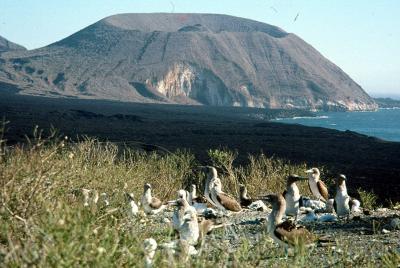Seismic waves penetrating to a depth of almost 200 miles report the discovery of an anomaly that likely is the volcanic mantle plume of the Galapagos Islands - it's just not where geologists and computer modeling had assumed.
The Galapagos chain covers roughly 3,040 square miles of ocean and is centered about 575 miles west of Ecuador, which governs the islands. Galapagos volcanic activity has been difficult to understand because conventional wisdom and modeling say newer eruptions should be moving ahead of the plate, not unlike the long-migrating Yellowstone hotspot.
New experiments put the suspected
volcanic mantle plume
at a depth of 155 miles and at a location about about 100 miles southeast of Fernandina Island, the westernmost island of the chain, and where generations of geologists and computer-generated mantle convection models have placed the plume.
The plume anomaly is consistent with partial melting, melt extraction, and remixing of hot rocks and is spreading north toward the mid-ocean ridge instead of, as projected, eastward with the migrating Nazca plate on which the island chain sits, says paper co-author Douglas R. Toomey, a professor in the
University of Oregon Department of Geological Sciences.

Isabella Island, where two active volcanoes are located. The location of the mantle plume, to the southeast of where computer modeling had put it, may explain the continued activity of volcanoes on the various Galapagos Islands. Credit: Douglas Toomey
The separating angles of the two plates in the Galapagos region cloud easy understanding. The leading edge of the Nazca plate is at Fernandina. The Cocos plate, on which the islands' some 1,000-kilometer-long (620-miles) hotspot chain once sat, is moving to the northeast.
The suspected plume's location is closer to Isabella and Floreana islands. While a dozen volcanoes remain active in the archipelago, the three most volatile are Fernandina's and the Cerro Azul and Sierra Negra volcanoes on the southwest and southeast tips, respectively, of Isabella Island, the archipelago's largest landmass.
The plume's more southern location, Toomey said, adds fuel to his group's findings, at three different sites along the globe encircling mid-ocean ridge (where 85 percent of Earth's volcanic activity occurs), that Earth's internal convection doesn't always adhere to modeling efforts and raises new questions about how ocean plates at the Earth's surface -- the lithosphere -- interact with the hotter, more fluid asthenosphere that sits atop the mantle.
"Ocean islands have always been enigmatic," said co-author Dennis J. Geist of the Department of Geological Sciences at the University of Idaho. "Why out in the middle of the ocean basins do you get these big volcanoes? The Galapagos, Hawaii, Tahiti, Iceland -- all the world's great ocean islands – they're mysterious."
The Galapagos plume, according to the new paper, extends up into shallower depths and tracks northward and perpendicular to plate motion. Mantle plumes, such as the Galapagos, Yellowstone and Hawaii, generally are believed to bend in the direction of plate migration. In the Galapagos, however, the volcanic plume has decoupled from the plates involved.
"Here's an archipelago of volcanic islands that are broadly active over a large region, and the plume is almost decoupled from the plate motion itself," Toomey said. "It is going opposite than expected, and we don't know why."
The answer may be in the still unknown rheology of the gooey asthenosphere on which the Earth's plates ride, Toomey said. In their conclusion, the paper's five co-authors theorize that the plume material is carried to the mid-ocean ridge by a deep return flow centered in the asthenosphere rather than flowing along the base of the lithosphere as in modeling projections.
"Researchers at the University of Oregon are using tools and technologies to yield critical insights into complex scientific questions," said Kimberly Andrews Espy, vice president for research and innovation and dean of the UO Graduate School. "This research by Dr. Toomey and his team sheds new light on the volcanic activity of the Galapagos Islands and raises new questions about plate tectonics and the interaction between the zones of the Earth's mantle."




Comments